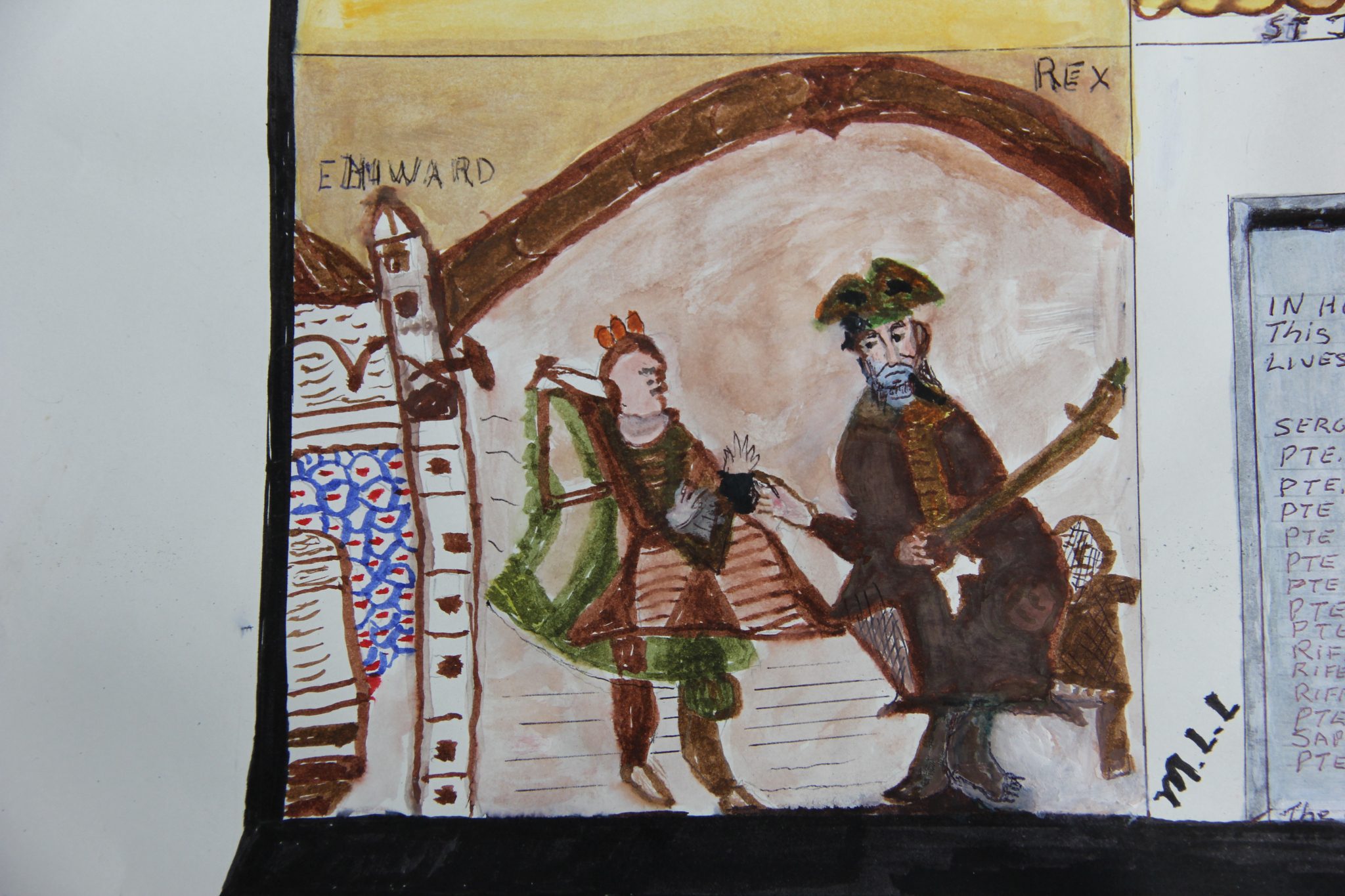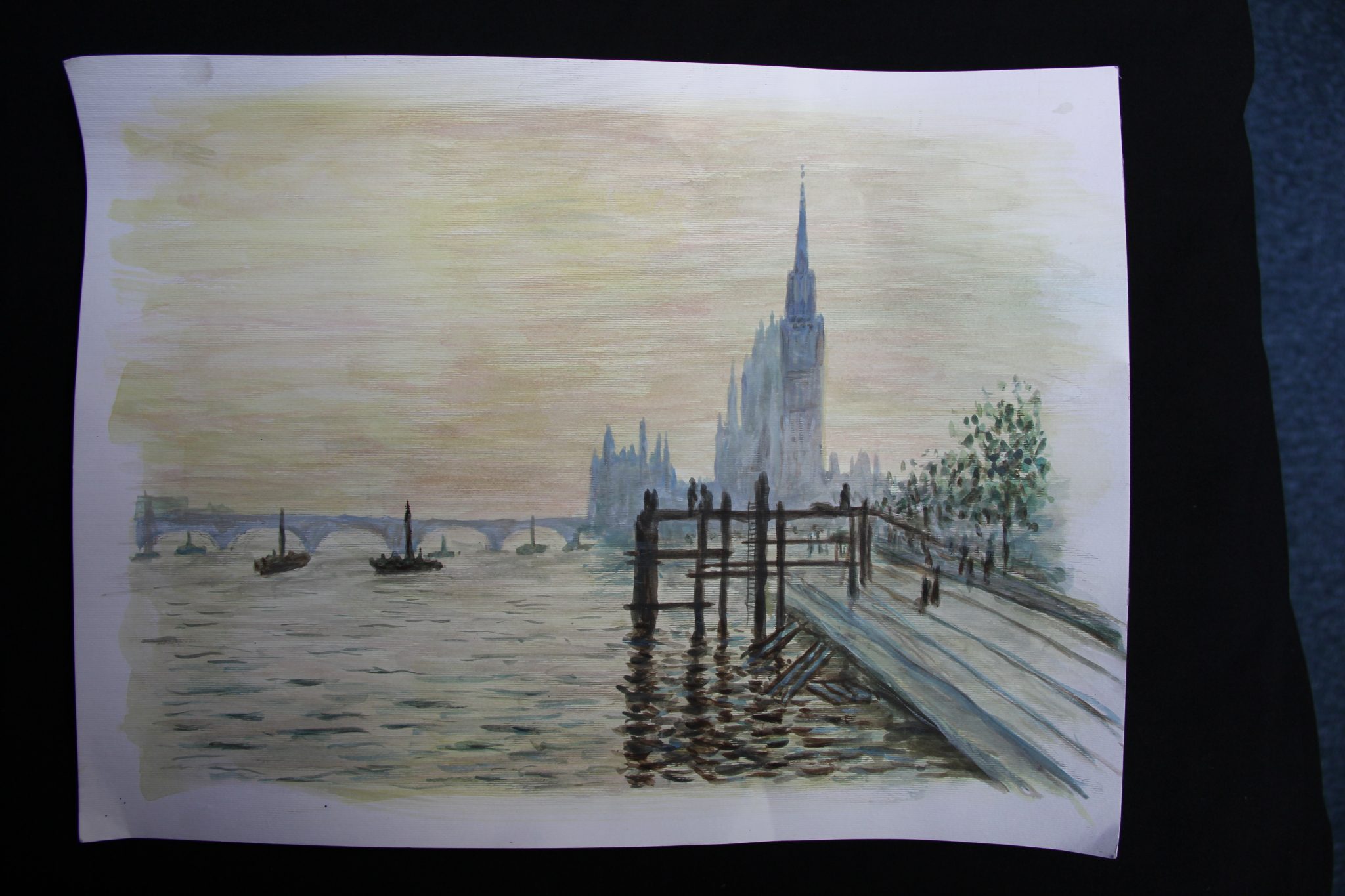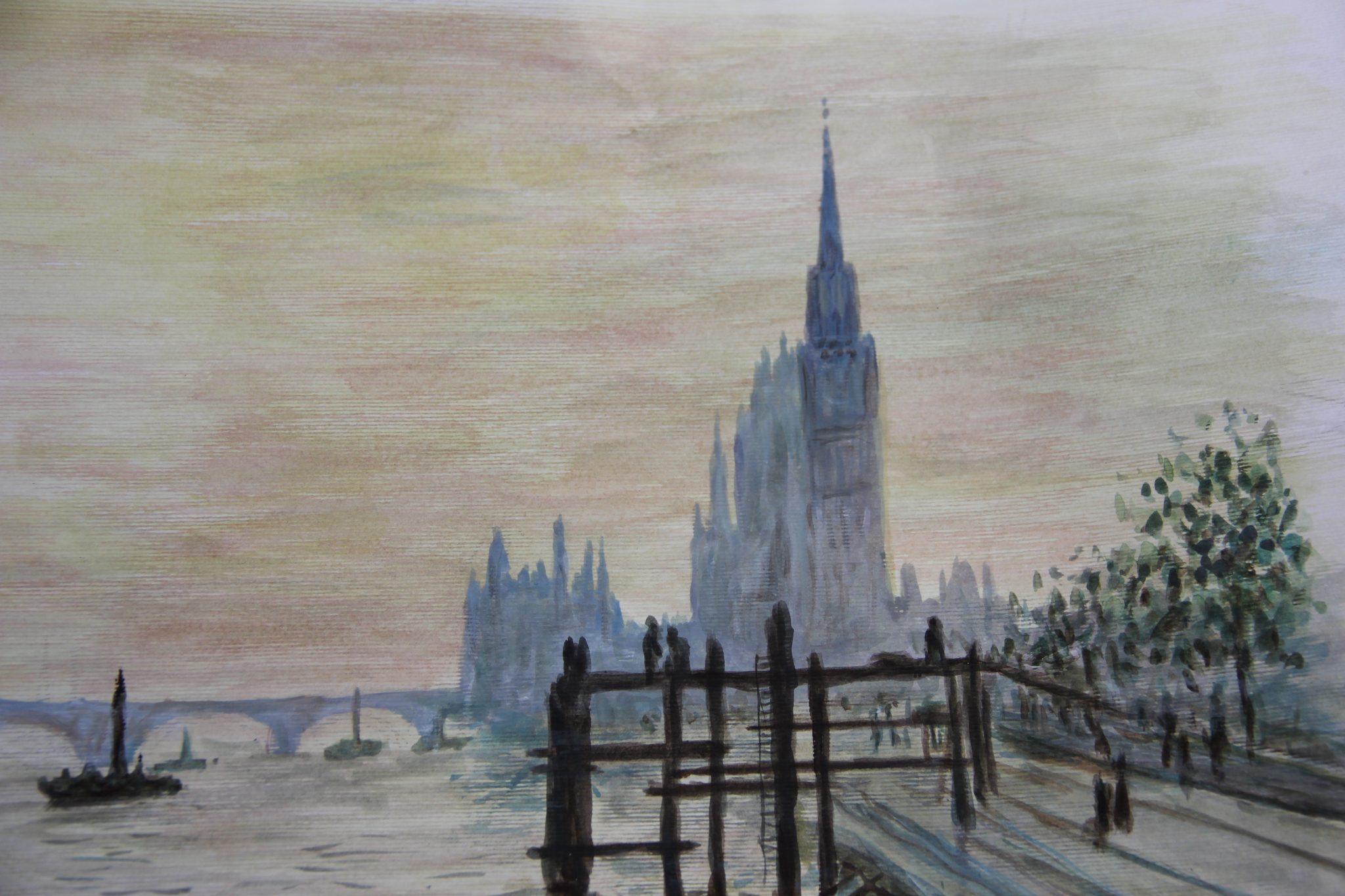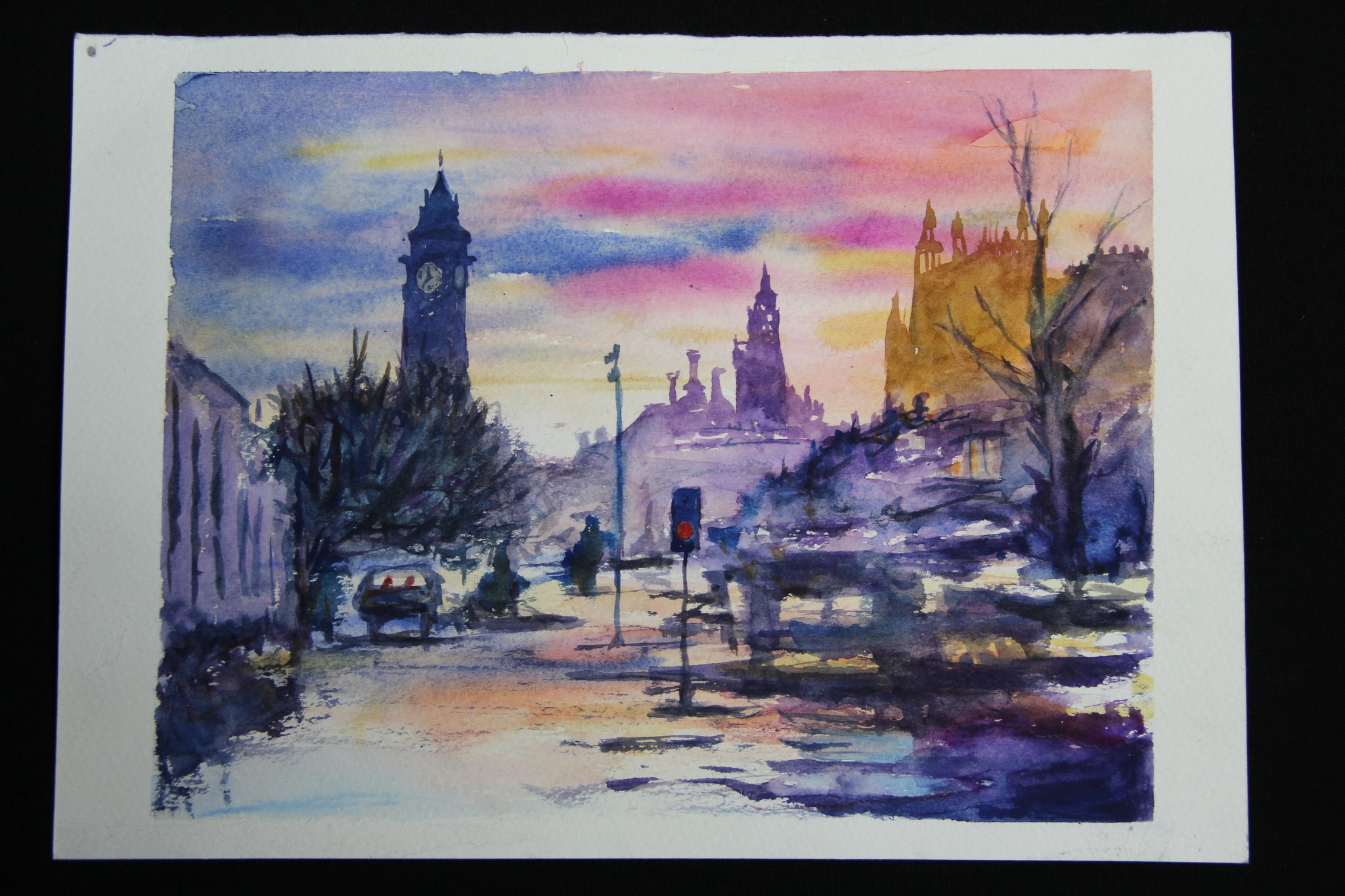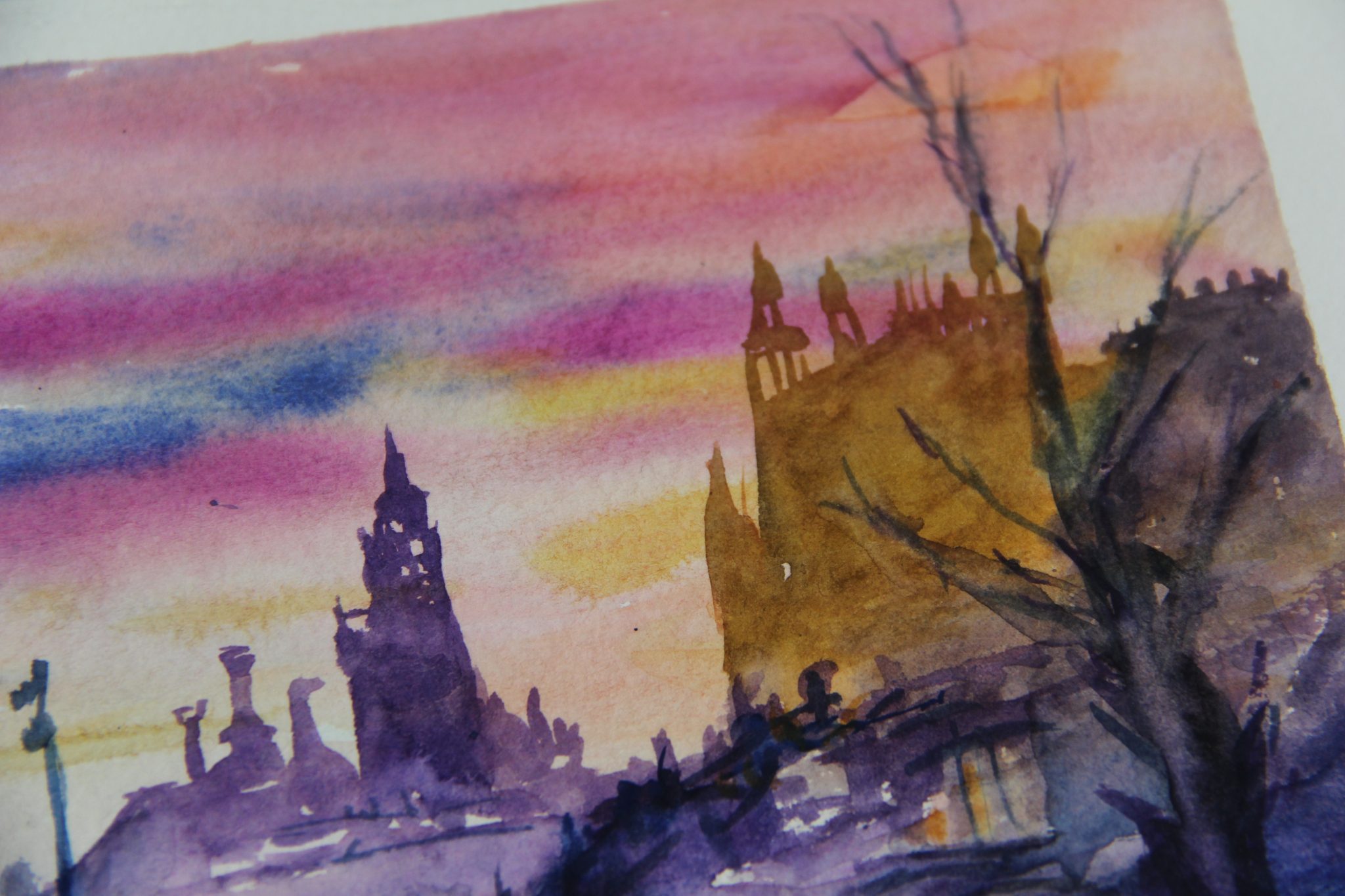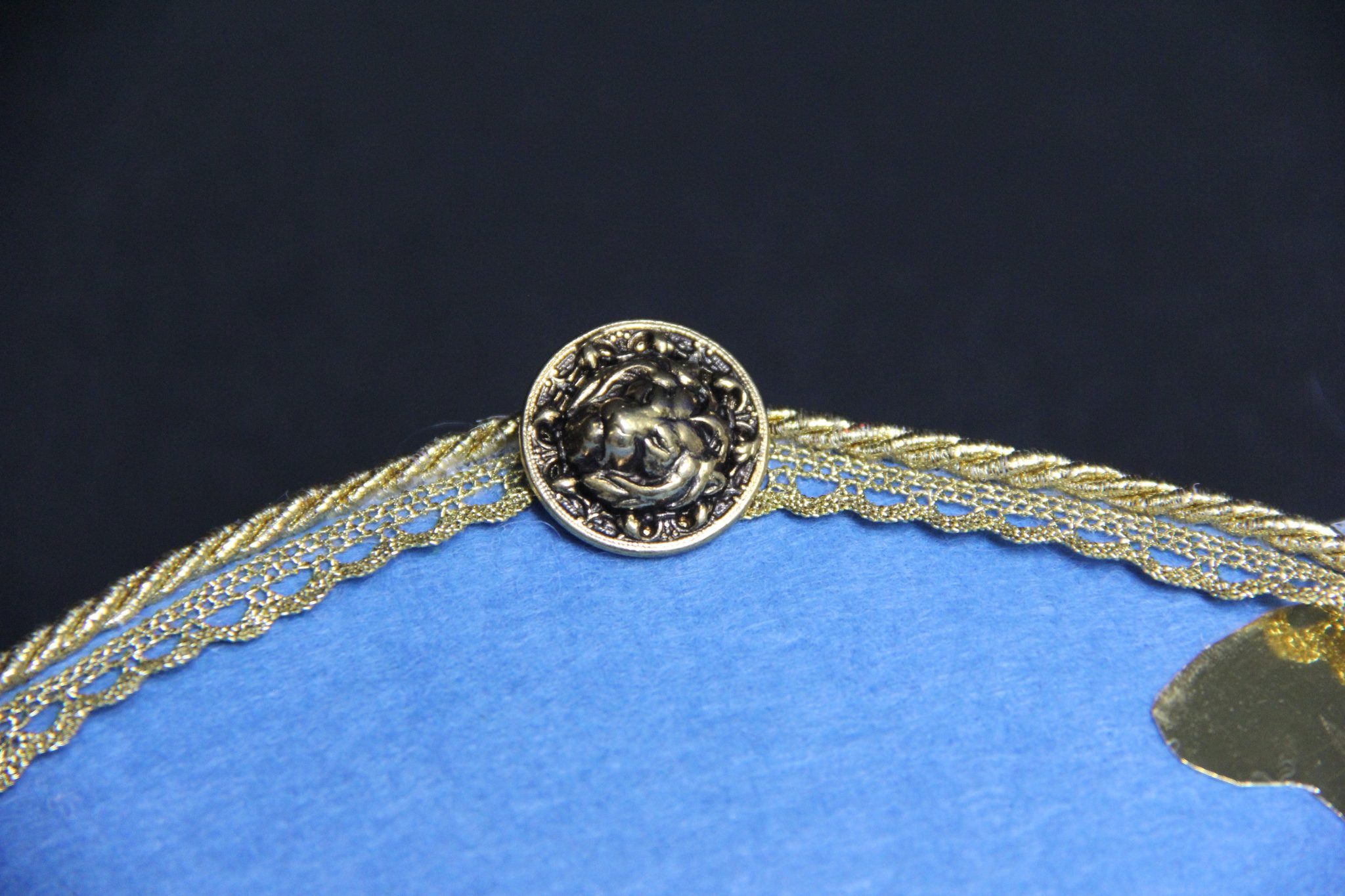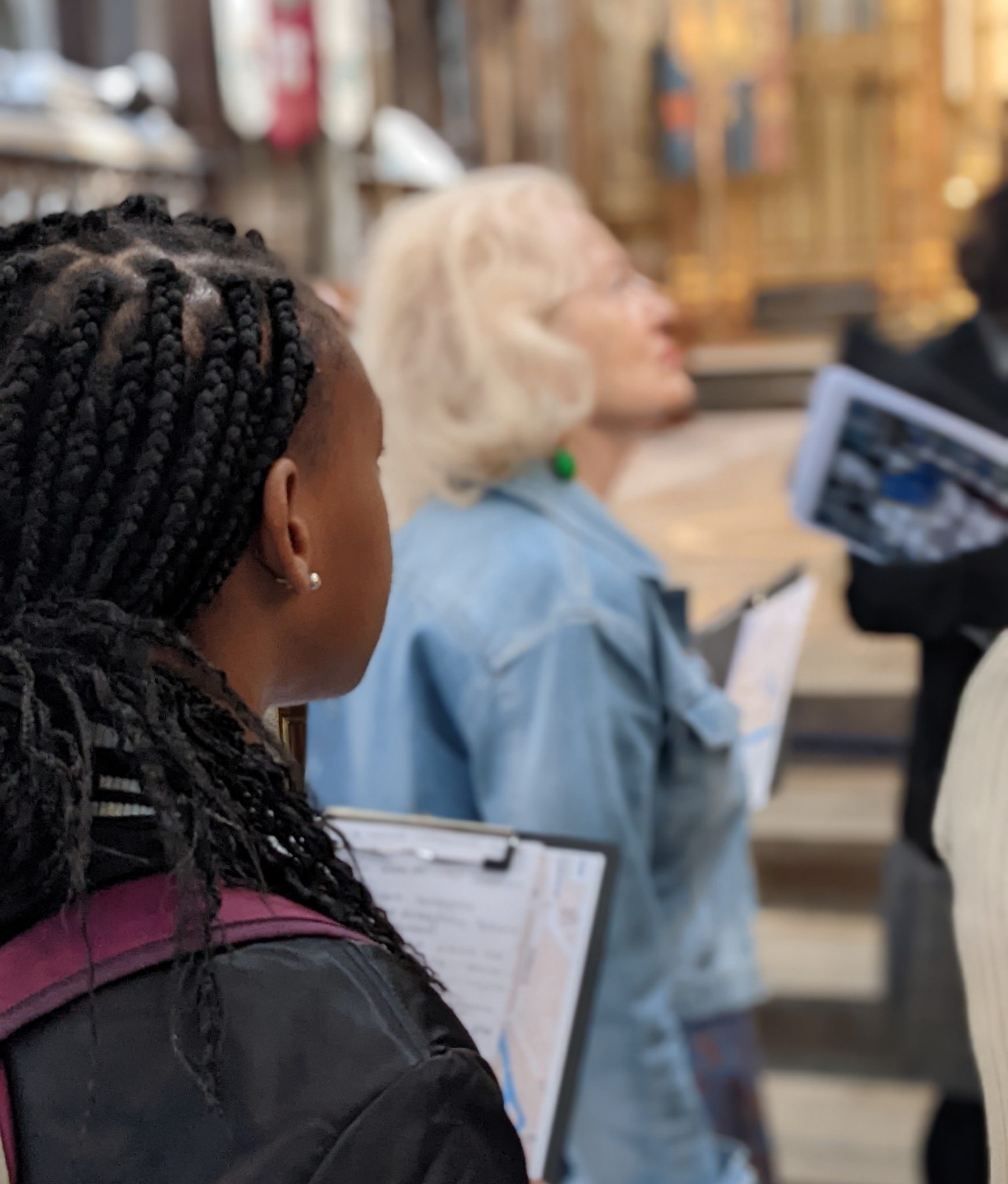The Stories of our Streets
A Heritage Trail
Would you like to uncover and explore stories of Westminster through the eyes of its residents?
Working with a group of local residents across generations, we learnt about the fascinating social history here in the streets of south Westminster, and in a series of workshops explored how their personal experiences and memories relate to the history all around them.
The results were a series of artworks created by our residents which offered a unique insight into both personal and public histories of Westminster. These formed the basis of our first Heritage Trail, which took place on the 9th and 10th July 2023 and explored South Westminster and its history.
Venue List
1. The Abbey Centre
34 Great Smith Street
London
SW1P 3BU
2. Westminster Archives
10 St. Ann’s Street
London
SW1P 2DE
3. St. Andrew’s Club
Alex Wizard House
12 OId Pye Street
SW1P 2DG
4. Duke of Edinburgh
Award House
7-11 St. Matthew Street
SW1P 2JT
5. Ravello Coffee
61-71 Victoria Street
London
SW1H 0HW
6. Grafton Arms
2 Strutton Ground
London
SW1P 2HP
7. Star Dry London
32 Strutton Ground
London
SW1P 2HR
Explore the Trail
Take an online wander around/through the artworks from our Heritage Trail, what inspired them and the local history connected.
1) The Abbey Centre
Rosie, 84
What have you made?
Picture with the bus and the butterflies.
What inspired you?
I have made a piece that makes me feel happy and inspired by all the fabulousness in and around Westminster. Positivity and being part of the community is what fully inspired me.
The History
The Abbey Centre frontage is what remains of Westminster’s first public baths and wash house. It was part of the old library complex, designed in 1891 by F.J. Smith. The entrance was to one side, and features lovely panels of sculptured swimmers by Henry Poole, then just 18 years old. The baths themselves were demolished in the 1990s to make way for the Westminster Archives Centre, just behind the Abbey Centre.
Westminster Abbey’s full name is the Collegiate Church of St Peter, Westminster – Great Peter Street round the corner is named after St Peter, who the first stone church was built in honour of.
On the next road the Abbey Orchard estate in Westminster dates from 1882. In medieval times, the orchard of Westminster Abbey stood there, but by the late nineteenth century, the area was an unhealthy maze of narrow alleys and courtyards. Cottages were crammed together, alongside stables, cowsheds, coalyards, lodging houses, and a ragged school for pauper children. Small and poorly ventilated dwellings were severely overcrowded, crime was rife, and the police entered the area at their peril.
2) Westminster Archives
Afsheen, 14
What have you made?
I have made a collage type piece as my final piece for the project. I went round Westminster Abbey and took photos of the parts of the building that interested me and turned those into this collage.
What inspired you?
I was inspired by the stories in the architecture of Westminster Abbey. I wanted to try to show the Abbey from a different perspective, which to me was emphasising the beauty of the architecture rather than the items that have been placed there after it was made. The room where we did the workshops was an Edward the Confessor part of the building, we learnt you could tell the difference by the shape of the arches!
Sofia, 16
What have you made?
Photo of Westminster and small poem
What inspired you?
I was inspired by the tour around Westminster makes you realise what is around and history that you wouldn’t necessarily know about.
The History
In the 1040s King Edward (later St Edward the Confessor) established his royal palace by the banks of the river Thames on land known as Thorney Island. Close by was a small Benedictine monastery founded under the patronage of King Edgar and St Dunstan around 960A.D. This monastery Edward chose to re-endow and greatly enlarge, building a large stone church in honour of St Peter the Apostle. This church became known as the ‘west minster’ to distinguish it from St Paul’s Cathedral (the east minster) in the City of London. Westminster gets its name from Westminster Abbey.
Edward’s Abbey survived for two centuries until the middle of the 13th century when King Henry III decided to rebuild it in the new Gothic style of architecture.
An architectural masterpiece, Westminster Abbey also presents a unique pageant of British history – the shrine of St Edward the Confessor, the tombs of kings and queens, and countless memorials to the famous and the great. It has been the setting for every Coronation since 1066 and for numerous other royal occasions, including sixteen royal weddings.
3) St. Andrew’s Club
Dija, 14
What have you made?
I have made a stained glass window, however without the glass I use my embroidery skills to sew on different colours in a pattern.
What inspired you?
What inspired me was the tour in Westminster Abbey as we visited the Queen’s window which was designed by David Hockney in 90 minutes. Although it wasn’t your typical church window it still had a meaning and was very minimalistic so I wanted to mimic and try to recreate a stained glass window myself.
Maria, 74
What have you made? What inspired you?
I’ve painted my own version of a window – each with a different section:
1) Watercolour painting will be a future flight car for young generation.
It inspired me to create it of the Saturday’s we learned about the history of Westminster Abbey.
2) St. James’s Park painting. Duck Island Cottage, Swiss chalet for a British bird-keeper – built in 184. Club room for the Ornithological Society of London, which once helped to look after the ducks and geese.
It inspired me to create it of the love I have for the park in Central London.
3) Painting King Edward the Confessor.
Inspired it for his power and royalty to the country.
4) Painting the memorial. The Old Pye Street plaque is one of 279 Great War memorials in Westminster.
Inspired it to remember the soldiers who died during the war, fighting for the country.
Maria, 75
What have you made?
I have recreated the David Hockney window in Westminster Abbey.
What inspired you?
The window caused a lot of controversy in the group, half the group really liked it, half thought it was wrong for the location.
Vera, 82
The History
During the walking tour of Westminster Abbey we looked at two of their stained glass windows, The Queen’s Window and The South Rose Window.
The Queen’s Window
The window was designed by David Hockney in 90 minutes on an Ipad and unveiled in 2018 to celebrate Queen Elizabeth II as England’s longest serving monarch. The window was previously a blank 19th century space.
The design is a country scene featuring hawthorn blossom and uses his distinct colour palette depicting the landscape and flora of the East Riding of Yorkshire, near his birthplace Bradford. Hockney was inspired by the work of Henry Matisse and Marc Chagall who also worked in stained glass.
The window measures 8.5 metres high and 3.5 metres wide.
It stands out in the Abbey as a contemporary colourful piece.
South Rose Window:
Dedicated to Hugh Grosvenor 1st Duke of Westminster, Grosvenor Estate – a large circular traditional stained glass window.
Hugh Grosvenor is grandson of Sir Thomas Grosvenor and Mary Davis. Mary Davis inherited part of the Manor of Ebury (where Mayfair is today) and part of ‘Five Fields’ which is partially located in Belgravia. This inheritance prompted the development of the Grosvenor estates.
Sir Richard Grosvenor, son of Sir Thomas Grosvenor and Mary Davis, started developing Mayfair and repurposing the swamps and pastures of Five Fields. Sir Richard’s son was Sir Hugh 1st Duke of Westminster continuing his father’s work, in plans to develop Mayfair.
Today the family represent one of the world’s largest privately owned international property companies. It was only in the 1950s that the family sold Pimlico to Westminster Council. Mary and Thomas’ current descendant is Hugh Grosvenor, the 7th Duke of Westminster, aged 31. Until recently, he was the second wealthiest person after the Queen in the UK.
4) Duke of Edinburgh

What have you made?
I have written a poem based on the changes over time in Westminster.
What inspired you?
We have learnt a whole host of history as well as stories from the group about their experiences of Westminster. I was inspired by the breadth of time we covered, from Devil’s Acre in the 1800s to our stories of Westminster.
Our Streets – The ‘clue’ is in the title: an awareness of the historical, social and political relevance of that upon which we, so unthinkingly walk upon!
Above; the Gothic spires
Below: the sheer miracle of humanity
The intellect, perception, skills, imagination and WEALTH required to create these magical towers of rock, glass and bronze.
Margaret, 85
Our Streets
A dark, fetid alley;
thin, bare feet slip, slide and squelch over icy cobbles;
A shadow moves!
Theft?
Rape?
Murder!
Then it’s hoof and carriage!
Wig, plume and glove
in a velvet and ermine lined gilt Sedan!
Now; a Sari flickers and flashes
rose, emerald and sapphire!
dreadlocks blow, laughing in the sun!
Click, clack the Louboutins,
Hush, hush the Adidas,
Easily, swiftly over carefully
Hoovered taxpayers concrete paving.
The History
This area of Westminster was a notorious slum referred to as the Devil’s Acre which consisted of the streets Old Pye Street, Great St. Anne’s Lane (now St. Ann Street) and Duck Lane (now St. Matthew Street)
In 1850 Charles Dickens wrote about this area in Household Words, in a piece called The Devil’s Acre:
‘There are multitudes who believe that Westminster is a city of palaces, of magnificent squares, and regal terraces; that it is the chosen seat of opulence, grandeur and refinement; and that filth, squalor, and misery are the denizens of other and less favoured sections of the metropolis. The error is not in associating with Westminster much of the grandeur and splendour of the capital, but in entirely dissociating it in idea from the darker phases of metropolitan life… [The] brightest lights cast the deepest shadows…There is no part of the metropolis which presents a more chequered aspect, both physical and moral, than Westminster.’
‘Begirt by scenes of indescribable infamy and pollution; the blackest tide of moral turpitude that flows in the capital rolls its filthy wavelets up to the very walls of Westminster Abbey.’
In the mid-1840’s plans were approved to run a road, Victoria Street, between Westminster and Victoria carving a channel right through the slum and work started in the Spring of 1847. The move was one of a number in the Victorian era to deal with the issue of a growing slum problem by simply bulldozing infrastructure through them. However the work led to the displacement of hundreds of families who simply moved to existing overcrowded slum areas in the capital.
5) Ravello Coffee
Pearly, 74
What have you made?
We decided to make a wreath dedicated to our lost loved ones, friends and family who have lived with us in Westminster and beyond. Making this wreath touched our hearts and made us quite emotional.
What inspired you?
On our walking tour of Westminster Abbey we saw the poppy’s placed in the entrance for the ‘Unknown Soldier’ where an unknown WW1 soldier is buried and visitors cannot walk over it. It was to commemorate all the lost lives.
I remembered going to the poppy factory in Twickenham where you could make a wreath to be put on the grave of our heroes like the one in Cenotaph.
The History
At the west end of the Nave of Westminster Abbey is the grave of the Unknown Warrior, whose body was brought from France to be buried in the Abbey on 11th November 1920. The grave, which contains soil from France, is covered by a slab of black Belgian marble from a quarry near Namur.
On it is the part of the following inscription, composed by Herbert Ryle, Dean of Westminster:
BENEATH THIS STONE RESTS THE BODY
OF A BRITISH WARRIOR
UNKNOWN BY NAME OR RANK
BROUGHT FROM FRANCE TO LIE AMONG
THE MOST ILLUSTRIOUS OF THE LAND
AND BURIED HERE ON ARMISTICE DAY
11 NOV: 1920, IN THE PRESENCE OF
HIS MAJESTY KING GEORGE V…
The body was chosen from unknown British servicemen exhumed from four battle areas, the Aisne, the Somme, Arras and Ypres. (some sources say six bodies but confirmed accounts say four).
6) Grafton Arms
James, 78
What have you made?
I have painted a close up of some trees
What inspired you?
Westminster is so green, full of trees and green spaces and I love to spend time outside.
The History
Westminster is steeped in the history of rights and votes for women.
Black Friday was a suffragette demonstration in London on 18 November 1910, in which 300 women marched to the Houses of Parliament from Caxton Hall in Victoria as part of their campaign to secure voting rights for women. The day earned its name from the violence meted out to protesters, some of it sexual, by the Metropolitan Police and male bystanders.
Local memorials include a statue of Emmeline Pankhurst in Victoria Tower Gardens, near the Houses of Parliament, and a memorial in Christchurch Gardens, near Caxton Hall, where the WSPU held its annual women’s parliament. A statue of suffragist Millicent Fawcett by artist Gillian Wearing was erected in Parliament Square in 2018 – the first statue of a woman and by a woman on Parliament Square.
In 1914 the Suffragettes placed a bomb beneath the Coronation Chair in Westminster Abbey which exploded at 5.40pm when there were some 100 people in the Abbey. A fragment was blown off the chair and a large quantity of plaster fell from the ceiling.
The dust of the plaster and the smoke from the bomb left the impression of a great catastrophe as people rushed from the building, however there were no injuries reported.
In 1928 all women over the age of 21 were given the right to vote due to hard work and campaigning of the Suffrage Movement and the Suffragettes.
7) Star Dry London
James, 78
What have you made?
Painted a picture of Westminster at the Thames set a few hundred years ago.
What inspired you?
Inspired by the rest of the members and also proud of whereI live, inspired mainly by Westminster itself.
The History
It is believed that the building that stood here prior to Star Dry London, was the building where Chartist William Cuffey held lots of his meetings!
Chartism was a working class movement, which emerged in 1836 and was most active between 1838 and 1848. The aim of the Chartists was to gain political rights and influence for the working classes. Chartism got its name from the People’s Charter, that listed the six main aims of the movement, the vote for all men over the age of 21 being the most significant.
Cuffey’s father was a slave in St Kitts but became a free man and ship’s cook. Today William Cuffey might have been considered disabled as he reportedly had a spinal deformity. He worked as a tailor in London, becoming politically active through a strike in 1834; and by 1839 he was a Chartist, famed for his powerful oratory and leadership.
Cuffey was involved in the Chartist Convention which organised a demonstration on Kennington Common in April 1848. Around 25,000 people gathered to march to Parliament with a ‘monster petition’. The government were clearly nervous of its potential. In preparation, thousands of special constables were recruited, institutions such as the Royal Mint and the Foreign Office requested greater protection from the Home Office, and lamps were to be lit early.
The march passed off peacefully, but the police prevented it from crossing the Thames. The petition was taken to Parliament by Chartist leader and politician Feargus O’Connor, but was later rejected, supposedly on the basis of the repetition of signatures and forgeries.
A few months later, in August 1848, William Cuffey was arrested for conspiring to ‘levy war against the queen, in order by force and constraint to compel her to change her councils’ and conspiring ‘with intent to depose the queen from the style, honour, and dignity of the imperial crown’ (CRIM 10/28). He was tried with two other Chartists, and in the end, Cuffey was sentenced to transportation for life. On 8 August 1849, aged 60, Cuffey set off aboard the Adelaide to the other side of the world: Van Diemen’s Land, or Tasmania as we call it today.
Although he was now old and in unfamiliar surroundings, this is not the end of Cuffey’s story. Despite receiving a pardon in 1856, Cuffey chose not to return to Britain and records in Australia show that he grew to be an important campaigner in his new home as well.
8) Open Age
Hannah, 17
What have you made?
Purply picture of Westminster
What inspired you?
I was inspired by the group and being part of the community in South Westminster, I also am new to art and it was great to work with James who was teaching me skills as well.
Maggie, 76
What have you made?
I have made my own version of a Blue Plaque to commemorate Billy Hughes, a local boy who had an incredible political journey.
What inspired you?
We learnt about Billy Hughes and I found his story really interesting.
Born William Morris Hughes in Pimlico 1862 to Welsh parents.
Died in Sydney, Australia in 1952.
Billy had quite a ‘naughty’ reputation and at the age of 22 decided on a life in Australia.
The key on the plaque is in reference to the story we heard about him when he managed to get himself out of a bad situation by unlocking a safe for a panicked official, Billy had simply seen the lost key and acted quickly, an example of his quick wit which got him out of tricky situations.
On arrival he worked in the outback of Queensland doing minor jobs such as boundary rider and an umbrella mender.
He moved to Sydney and at the age of 29 became fascinated with politics and helped form the Labour League.
In 1915 at the age of 53 he became Australia’s 7th Prime Minister – what an honour – and remained in that position until 1923. This of course meant he led the country through World War 1. AS PRIME MINISTER
He introduced income tax due to all the expenditure during the war
He established the Common Wealth Police Force in 1917
Known as ‘Little Digger’
Digger – Australian soldier
Little – Small stature
Pimlico should be so proud of him.
The History
At the west end of the Nave of Westminster Abbey is the grave of the Unknown Warrior, whose body was brought from France to be buried in the Abbey on 11th November 1920. The grave, which contains soil from France, is covered by a slab of black Belgian marble from a quarry near Namur.
On it is the part of the following inscription, composed by Herbert Ryle, Dean of Westminster:
BENEATH THIS STONE RESTS THE BODY
OF A BRITISH WARRIOR
UNKNOWN BY NAME OR RANK
BROUGHT FROM FRANCE TO LIE AMONG
THE MOST ILLUSTRIOUS OF THE LAND
AND BURIED HERE ON ARMISTICE DAY
11 NOV: 1920, IN THE PRESENCE OF
HIS MAJESTY KING GEORGE V…
The body was chosen from unknown British servicemen exhumed from four battle areas, the Aisne, the Somme, Arras and Ypres. (some sources say six bodies but confirmed accounts say four).
About the Project
Each year at SouthWestFest we always receive feedback conveying the demand for heritage projects, walking tours, opportunities for people to learn about and explore south Westminster. And in late 2021 we thought it was time we developed our own large heritage project.
We had early discussions with our partners at the Families and Learning Team at Westminster Abbey and started scoping out ideas which we could approach The Heritage Lottery Fund with. This is how this project began.
Phase One
We brought on board Westminster Archives, and decided to reach out through specific local organisations for participants. Open Age, south Westminster is a group for local over 50s who can take part in many of the free and low-cost activities put on and City Lions, a Westminster City Council initiative to support and give access to local young people and creative careers.
We developed a series of four workshops where we worked with our intergenerational group to learn about the local history through two walking tours, one led by the Archives and one by the Abbey. Themes that came up were: Power and Status, Place and Geography, Future, Conflict, Social Mobility, Class, Strong Female Leaders, Money and Business, Education and Centres of Community.
We were also really interested in hearing about our participant’s personal memories and experiences of living in Westminster. We heard about first kisses, deaths of loved ones, favourite open spaces, reflections on how the area has changed and hopes for the future.
We then reviewed what they’d learnt, what piqued their interest or spoke to their experiences and tasked them with creating something that was inspired by the workshops. The result was fantastic, a wide selection of paintings, photos, poems and more sculpted pieces.
Phase Two
Their artworks have been turned into this Stories of Our Streets Heritage Trail! You can head out discover the artworks, what inspired them and learn more about this area of south Westminster.
Throughout the process we worked with: Afsheen, Dija, Hannah, Kathy, Maggie, Margaret, Maria, Maria, Maria, Maria(!), Pearly, Rene, Sophia, Sylvia, and Vera. A wonderful group of local people who came open minded and ready to take part.
Thank you to The Heritage Lottery Fund for supporting this project!








